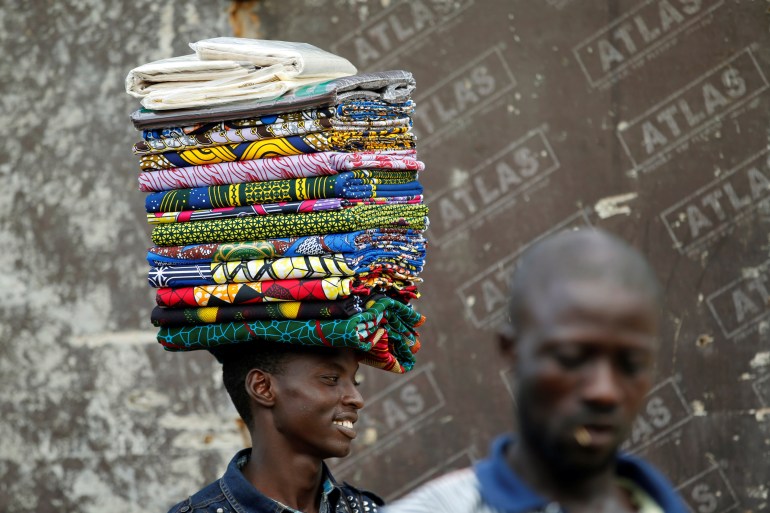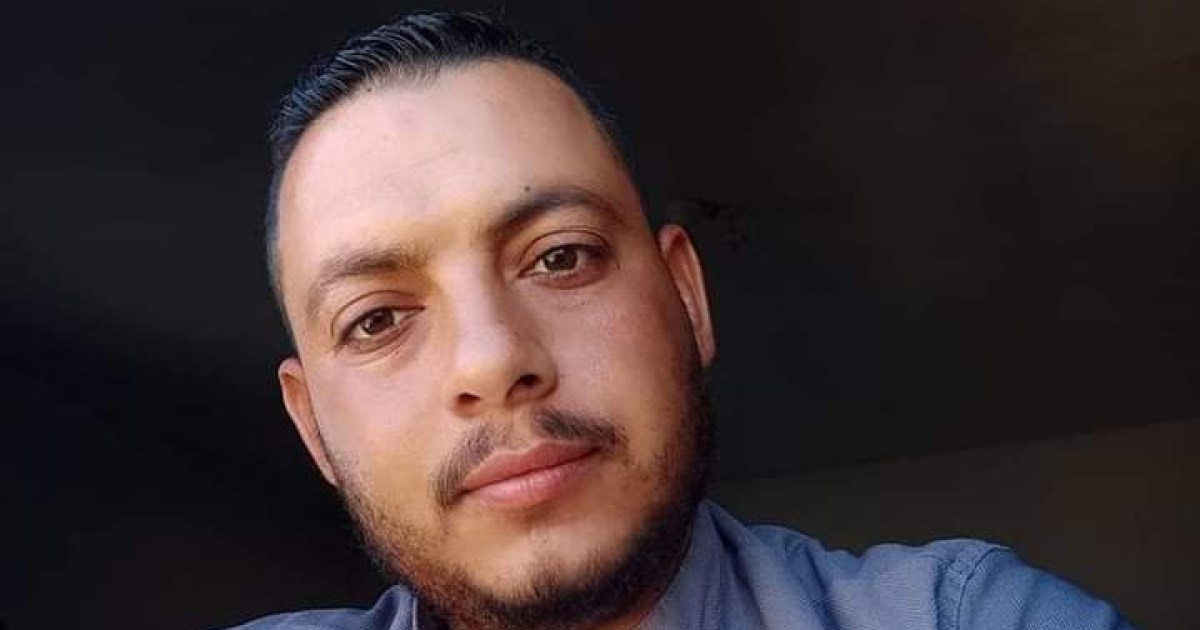
Accra Ghana – On a weekday in December, the fabric section of the busy Makola market in Accra was unusually quiet for the end-of-year festive season. Female traders in large woven hats sat in front of their stalls, chatting and swatting away tired flies. Behind it, colorful African wax textiles were stacked in rows from floor to ceiling, waiting to be purchased.
Vida Yeboah, one of the traders, said the stalls are usually bustling with customers looking for the latest designs which they can take to their tailors to be cut and sewn into different styles, from baggy dresses in A- Line to tops and skirts celebrate the New Year celebrations. But Ghana’s shaky economy has forced many to shun the tradition.
“Since COVID, schools started back in December and that means most people are thinking about how their sons and daughters would go to school,” the 55-year-old said. Schools are normally on vacation in December, but after the long pandemic break, many schools’ schedules have changed. “Now there is no money. People prefer to spend their money on other things, or they go and buy the small ones.”
The “small” brands Yeboah is referring to are the much cheaper versions of African wax prints that have been flooding the markets in Ghana and across Africa for years, giving stiff competition to the “original” producers. The fabrics imported from China often feature designs that imitate more established brands and sell for a third to a tenth of the price. Some are outright counterfeits, claiming to be recognizable brands on labels with typographical errors.
But although these Chinese-made fabrics have a bad reputation, some say they are becoming increasingly high-quality, their bright designs are becoming more stylish and their colors no longer fade after washing.
“Some people say it’s good,” Yeboah said. “The original is too expensive, even I don’t sell it,” she added, pointing to her stash. It sells Hitarget, a popular Chinese-made brand that is considered a high-quality, cheaper alternative to big brands and is way ahead in the “small” sector.
“This is 90 cedis ($8), which people can afford,” Yeboah said, picking up a blue and orange print with geometric patterns. “If you don’t have money for big ones, at least buy something before you leave the market.”
Made in the Netherlands, loved in Africa
Most commonly known as Ankara, the origin of the colorful fabric that has come to embody the essence of Africanness on the continent is not itself African for diasporans who want to remain connected to their roots.
The material originated when Dutch craftsmen in the 19th century attempted to mass-produce by machine the intricate, hand-crafted designs of Javanese batik prints from the Dutch East Indies, now Indonesia. The designs, made using a wax-resistant dyeing method that left the same intensity of color on both sides of the simple cotton spreads, were not well received. But European printers soon discovered that their invention was attracting unexpected attention elsewhere – in Africa.
Several Europeans, including 22-year-old Pieter Fentener van Vlissingen, a Dutch manufacturer, began producing the material in bales, cutting them up by the meter and transporting them to busy cities like Accra, where traders from other countries traveled to buy from them. The myth goes that the name “Ankara” came from Hausa traders across West Africa who tried to name the fabric after the place where they bought it – Accra.
In West and Central Africa, the vibrantly colored fabric sparked a style revolution. People, especially women, wore the fabric everywhere – at weddings, naming ceremonies, funerals. The new fabric soon displaced native materials such as the earth-blue batik pattern Adire of the Yorubas in Nigeria and the flashy, hand-woven kente of the Ashanti and Ewes in Ghana, which were heavier and not suitable for everyday use like Ankara.
Vlissengen’s company was at the forefront of the new era.
“It has been 177 years of ups and downs and we intend to stay here for another 100 years,” Perry Oosting, CEO of Vlissengen’s company, now called Vlisco, told Al Jazeera from the office in Helmond. The brand has become the continent’s most popular wax print manufacturer, presenting itself as an “original” luxury brand amid a sea of counterfeit and counterfeit copies made in China. Six yards of Vlisco cost up to 220 cedis ($200), but imitations cost much less.
“If you are successful, you will be copied,” said Oosting. Vlisco has trademarked its QR code designs and is now training customs officials in the Democratic Republic of Congo – one of its largest markets – to spot counterfeits. But there is still competition from small businesses.
“We’ve been through so much over the years and it’s built our resilience,” Oosting said, adding that counterfeiting isn’t the worst thing Vlisco has ever seen. “We have seen coups, we have seen wars in Africa. We plan to stay here much longer.”

The Nana Benz era
In those early days of African wax printing, enterprising African women worked with European manufacturers like Vlisco to develop beautiful new patterns that also had meaning and for which the women acquired exclusive distribution rights.
In Togo, where the market had shifted due to Kwame Nkrumah’s protectionist policies in Ghana, the “Nana Benzes” were particularly adept at monopolizing prints. The group of several female traders was crucial to Vlisco’s success.
Nana Benzes were so successful between the 1960s and 1980s that they became the first female millionaires in Togo, the only ones who could afford luxury Mercedes-Benz cars, earning them their nickname.
However, the Nana-Benz models have now been forgotten as production was relocated from Ankara to China.
This also applies to the local wax print brands that emerged in the mid-20th century – the era of African independence – to localize Ankara production, labeling it fully African and breaking the dominance of European printers like Vlisco still producing in the Netherlands.
In 1966, Ghana established the Ghana Textiles Printing Company (GTP), with the government holding majority ownership. Around the same time, Akosombo Textiles Limited (ATL) emerged, particularly known for its Adinkra symbols borrowed from the Gyaman ethnic group. In Nigeria, the United Nigerian Textile Mills (UNTL) has partnered with Hong Kong’s Cha Group to open a factory in the northern state of Kaduna. In Ivory Coast, Uniwax was born – a partnership between the Ivorian government and Unilever, the British consumer goods manufacturer.
But a series of problems, including government policies, counterfeiting, lack of infrastructure and the unavailability of locally grown cotton, forced many print shops to close or sell off, costing hundreds of garment workers their jobs.
GTP and Uniwax are now subsidiaries of Vlisco. Vlisco’s Oostings says although its subsidiaries produce locally, Vlisco itself has no immediate plans to move production from Helmond to the continent.
Some brands are looking to re-localize production but are facing similar problems.
Lome’s Wina wax is designed locally but manufactured in China due to a lack of electricity, Marlene Adanlete-Djondo, the founder and descendant of Nana Benz, told Jeune Afrique. Producing in China is an attempt to adapt at all costs while offering reasonable prices.
“Uniwax in Ivory Coast and GTP in Ghana were purchased by Vlisco, certainly due to lack of financial contributions,” Adanlete-Djondo said. “We don’t want this kind of future for Wina Wax.”
Feels soft
With all types of smalls flooding the market, it is harder to distinguish which is a good small and which is a bad small.
In Makola, young women arrange rolled-up “smalls” on flat trays balanced on their heads and bargain with them. All brands have words like “Guaranteed” or “Real Wax” on their edges.
But Augustina Otoo, an Accra-based fashion designer, said it is often the feel of the Ankara fabric and its flexibility that lets you know which are high quality and which are inferior, regardless of the name, brand or words printed on the fabric .
Most cheap imports use cheaper grades of cotton for production and even mix the cotton with fabrics such as polyester, while authentic loincloths are made entirely of cotton, Otoo, 26, added. While high-quality Ankara fabrics are soft to the touch and will give under the heat of an iron, some small fabrics lack this malleability, making them difficult to sew into the elaborate styles that customers demand.
“Some of them are like rubber, some of them even feel like paper,” Otoo said, laughing at her own analogy. “I sewed a lot of them. When ironed it is so stiff that it wrinkles. And if you want to straighten it, it just stays stiff. They put some shiny material on it that fades when you wash it. It doesn’t even take three months.”
But that hasn’t stopped her customers from buying them.
“Especially this season we have seen a lot of new designs in the small models,” said Otoo. There is little she can do to convince her customers to buy more authentic brands, she added. “I just provide the service and collect my money.”






Recent Comments